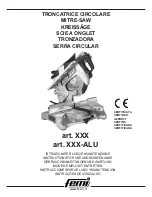
GB | 35
7. Technical Data
AC motor
230 V~
50Hz
Power
2000 Watt
Operating mode
S6 40% *
Idling speed
4800 min
-1
Carbide saw blade
ø 254 x ø 30 x 2,8 mm
Number of teeth
24, 48
Thickness riving knive
2,5 mm
Min. workpiece size
W x L x H
10 x 50 x 1 mm
Table size
546 x 630 mm
Cutting height max. 90°
87 mm
Cutting height max. 45°
55 mm
Height adjustment
0 - 87 mm
Saw blade, swivelling
0 - 45°
Mitre angle
0 - 45°
Extraction connection
ø 40 mm
Weight ca.
21,5/22,5 kg
Laser class
2
Laser wavelength
650 nm
Laser power
≤ 1 mW
Laser module power
supply
2 x 1.5V (LR03 / AAA)
Not supplied
* Operating mode S6 40%: Continuous operation with
intermittent load (cycle time 10 min). In order not to
heat the motor more than permitted, the motor may
only be operated for 40% of the cycle time with the
stated nominal power and must then continue run
-
ning for 60% of the cycle time without a load.
Noise emission values
Sound values were measured in accordance with EN
62841.
Sound pressure level
L
pA
93,5 dB(A)
Uncertainty K
pA
3 dB
Sound power level L
WA
106,5 dB(A)
Uncertainty K
WA
3 dB
Wear hearing protection.
The effects of noise can cause a loss of hearing. Total
vibration values (vector sum of three directions) de
-
termined according to EN 62841.
Safety instructions for handling batteries
1.
Attention: Risk of explosion with improper re
-
placement of the batteries. Only replace the bat
-
teries with batteries of the same or an equivalent
type. Observe the “Technical data”.
2.
Batteries must not be charged, reactivated by other
means, taken apart, thrown into fire or short cir
-
cuited.
3.
Avoid contact with the skin, eyes and mucous mem
-
brane. In case of contact with battery acid, the af
-
fected area must be rinsed immediately with plenty
of clean water. Seek medical advice immediately.
4.
If batteries are swallowed or enter the body in
any other way, seek medical advice immediately.
Keep batteries away from children and animals.
5.
Remove batteries from the battery compartment if
they are depleted, or if the circular table saw is out
of use for an extended period of time. This avoids
damage that may arise due to batteries leaking.
6.
Never expose batteries to extreme conditions by
storing them on radiators or in direct sunlight for
example.
7.
Clean the battery and device contacts if neces
-
sary before insertion, with a little emery cloth for
example.
8.
Ensure correct polarity during insertion.
9.
Do not mix old and new batteries or batteries of
different types or manufacturers!
Residual Risks
This power tool has been constructed in accord
-
ance with the latest technology and the generally
recognised safety regulations. Nevertheless, it is
possible that individual residual risks may occur
during operation.
•
Electrical hazard if improper electrical connection
cables are used.
•
In addition, concealed residual risks may be present
in spite of all the precautions that have been taken.
•
Residual risks can be minimised by observing the
„Safety instructions“ and „Use in accordance with
the designated purpose“, as well as the operating
instructions.
•
Do not put any unnecessary stresses on the ma
-
chine: excessive pressure during sawing will quickly
damage the saw blade. This may result in a reduc
-
tion in the performance of the machine, as well as a
reduction in the cutting accuracy.
•
Avoid switching the machine on by accident: when
inserting the plug into the socket, the power button
must not be pressed.
•
Use the tool which is recommended in this manual.
This will ensure the optimal performance of your saw.
•
Keep your hands away from the working area when
the machine is in operation.
• Before you carry out any adjustments or servicing
work, turn the device off and remove the mains plug.
Summary of Contents for MPSCST255MM2
Page 2: ......
Page 7: ...7 1 2 3 4 5 6 7 8 9 10 11 12 13 A B C D E F G H I J K L 28 ...
Page 44: ...44 ...
Page 46: ...46 ...
Page 48: ...Cet appareil ses accessoires piles et cordons se recyclent ...














































